How Carousels and VLMs Optimize Space
Comparison: speed, accuracy and space utilization
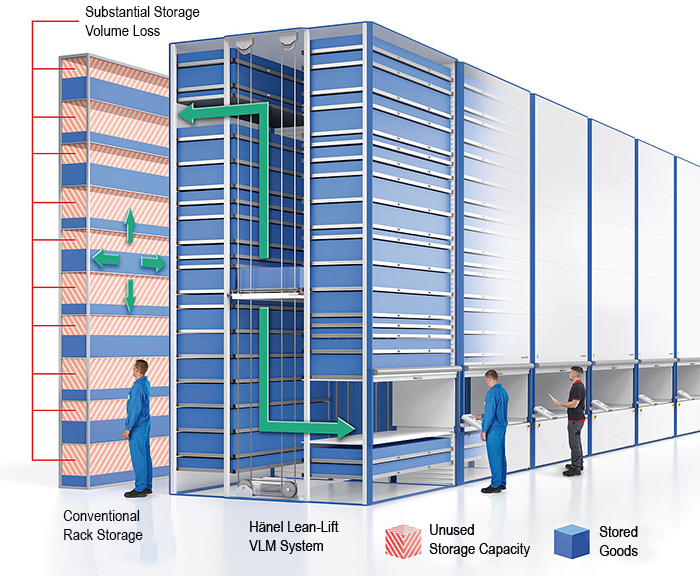
Above: VLMs condense space more efficiently than conventional storage racks, or even mini load systems. They can use the space more effectively because less “air space” is needed for the storage capacity.
Companies install carousel systems and vertical lift modules for many reasons, including flexibility, storage decentralization, operator access, retrieval times, security consolidation and picking accuracy gains. One of the most important reasons is the way they optimize space.
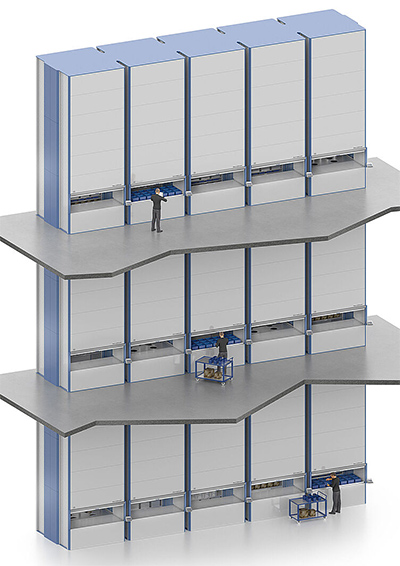
Vertical lift modules and vertical space efficiency
VLMs are enclosed systems with a series of trays stored on either side of a central elevator that retrieves and delivers trays to a picking station. This design bakes in vertical utilization efficiency in several ways.
Vertical space utilization and racking systems in large warehouse spaces
Most warehouses you see take only partial advantage of their high cube air space. They usually have at least some available vertical space. Rack is great at utilizing vertical air space through the central footprint of your facility, but often ignores the edges, the walls and other areas where air space remains unused.
Read more: Laying Out Your Pallet Rack System for Maximum Efficiency
VLMs installed against a wall consolidate storage more efficiently than a single rack row in the same space, if the storage mix fits the application. VLMs can be extended past the roof or into a second story, if needed. No other system matches carousels’ vertical utilization for each-picking or small parts.
Above: video from Cisco-Eagle’s WERC 2024 panel discussion on space optimization and alternatives to moving or relocating facilities
Comparing VLMs to other storage options
While there is always a business case for every storage and handling option, we’re focusing on space utilization in this analysis. All of these methods can be used in an efficient storage system.
| Feature | VLM | Shelving | Mini-load AS/RS | Carton flow |
|---|---|---|---|---|
| Vertical utilization | Up to 90% of available height | 12′ (typical) | Aisle clearance limitations | Limited by reach <12′ |
| Dynamic height | Adjustable trays | Fixed shelf spacing | Some flexibility | Fixed track heights |
| Aisle requirement | Aisle at the pick window | Up to 50% of floor space | 20-30% for robot movement | Aisles required for picking and restock |
| Density | Extremely high | Low to moderate | Moderate to high | Good – but limited by track spacing and height |
| Best use case | SKU diversity; vertical storage density | Great for low-cost storage | High-density automation for uniform loads | Fast throughput picking |
Carousels and VLMs can be extremely tall — up to 70 feet depending on the system and other factors. Within that height, they’re extremely dense. Because you store products dynamically, you can slot them based on height to reduce vertical space usage within the carousel. VLMs are not just tall. They’re optimized to use every inch of their internal, vertical space.
Storage density, shelving and carousel systems
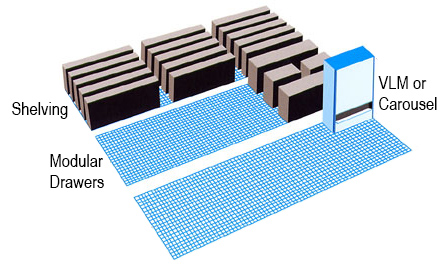
This illustration compares floor space consumption for a vertical carousel, traditional shelves and modular drawer units
Depending on the system and application, VLM manufacturers estimate space savings of 60% to 85% compared to shelves or even shelving with modular drawers.
- Because they eliminate fixed shelf heights, VLMs use vertical space more efficiently than shelves. For example, if one VLM tray holds items that are 5″ tall and another holds 10″ items, you can adjust the tray spacing to that exact gap. Shelving and racks, with their fixed heights, will waste that five-inch gap on any shelf that stores the 5″ product. You can dynamically adjust the spacing between VLM trays based on your inventory mix. Storage positions tend to become rigid because adjusting shelf heights is harder and slower for shelving. Bottom line: you can fit less into an equivalent amount of shelf space.
- You can adjust shelf heights, but not easily and not quickly as inventory changes.
- Up to half your floor space must be dedicated to shelving aisles. VLMs have no significant aisle requirements.
- If you’re manually picking from shelves, you’ll need ladders to reach anything outside human reach. This is a severe height limitation.
- Improved ergonomics are baked in: picks are made in the ergonomic “golden zone.”
- Picking is naturally faster than any manual storage method.
VLMs, space utilization and mini-load AS/RS: inventory considerations
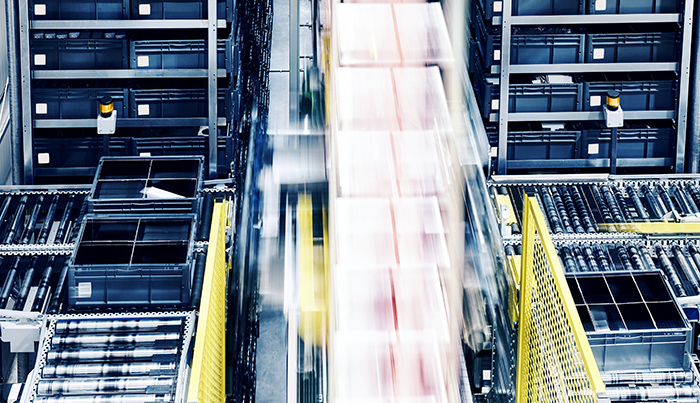
Both VLMs and AS/RS deliver fast, space-efficient storage and handling systems. Both are expensive and demand higher levels of storage, throughput and efficiency to justify these costs. VLMs and carousels are ideal for diverse inventory in high-ceiling facilities driven by a need for vertical space optimization. On the other hand, mini-load is better suited for high-throughput environments where you’re retrieving lots of items at high speed.
VLMs are best when you have:
- A large and varied number of SKUs
- Facilities with high ceilings or multiple stories
- The need for optimized goods-to-person workflows
VLMs are effective for goods-to-person workflows in industries such as e-commerce, healthcare and manufacturing where their compact footprint and dynamic storage shine.
When should you consider AS/RS?
- High-throughput operations with uniform or semi-uniform inventory you can count on
- When you’re executing bulk picks or larger scale replenishment
- AS/RS excels for automation in larger scale operations with significant horizontal movement
Mini-load systems are ideal for applications like replenishing order fulfillment lines or palletizing operations in large distribution centers due to their inherent speed and ability to plug into larger scale material handling systems, conveyors and other automation equipment.
Carton flow and VLMs
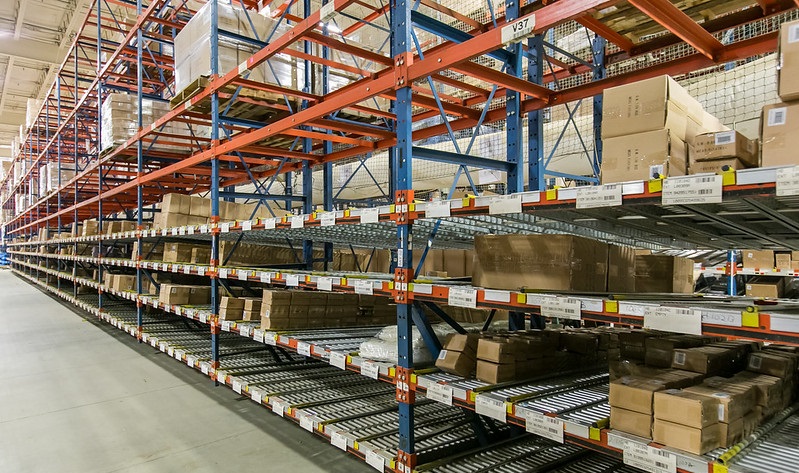
While carton flow systems are effective for high-throughput operations, VLMs use space more efficiently because they fully utilize vertical space, eliminate aisles and adjust to inventory changes. For operations with limited space or diverse inventory, VLMs offer a higher storage density and a smaller overall footprint.
- Carton flow is ideal for higher throughput applications where the same SKUs are constantly picked from the same storage locations.
- If your ceilings are low, carton flow is one of the best storage density solutions.
- VLMs excel in storage density for operations with tall ceilings and limited space.
- Use a VLM when your inventory is diverse and shifts over time.
It’s about form, space, function and operation
All of these storage alternatives have their place, and any of them can work based on your KPIs and specific requirements. You may not have the throughput requirements for carton flow to shine, or the high ceilings and inventory variety that carousels take strong advantage of. You may have both the space you need and the operational speed necessary for shelving. The more rigorous inventory and speed requirements that help AS/RS shine could be your reality.
But if your operation is short of space, and you have the other necessary needs, vertical lift modules are probably the most space-efficient storage system.
Read more
- Goods-to-Picker Methods and Alternatives
- Improve Productivity with Ergonomic Storage System Design
- Saving Space in Rack Storage Areas
Scott Stone is Cisco-Eagle's Vice President of Marketing with 35 years of experience in material handling, warehousing and industrial operations. His work is published in multiple industry journals an websites on a variety of warehousing topics. He writes about automation, warehousing, safety, manufacturing and other areas of concern for industrial operations and those who operate them.



